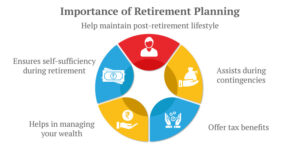If you’re planning to retire in the near future, you need to consider your retirement investment options. You need to make sure that your assets are protected and that your family can take care of your assets. These plans can be a great way to provide for your future, and they can also help you lower your taxes. You may also consider a 401(k) plan, which requires employee contributions and lowers your taxable income.

What are retirement investment options?
One of the best ways to create a diversified income stream during retirement is to invest in dividend stocks. These investments offer income and capital appreciation potential and provide built-in returns no matter what happens to the stock price. However, the principal value of dividend stocks can fluctuate more than other forms of income, and not all companies are reliable in their dividend payouts. In addition, dividend income is subject to higher tax rates.
Another option for people who are nearing retirement age is to purchase life insurance. Life insurance, available in various forms, can provide a death benefit as well as build a cash value that can support retirement needs. The cash value may be withdrawn in a lump sum or an annuity depending on the policy. The latter is more popular than the former, as it allows the individual to pay into the plan over a period of time. Premium payments can begin at age 50, and they increase over the course of a person’s life.
SEP IRAs is another retirement investment option for small business owners and self-employed individuals. These plans are similar to traditional IRAs, but they are only available to business owners and employees who work for themselves. These types of plans allow participants to make pre-tax contributions, reducing their taxable income, and growing tax-deferred until retirement. The contribution limits for these plans will increase to $61,000 in 2022, up from the current $58,000 limit.
Why retirement plans are important
Having a plan for retirement is crucial for a number of reasons. It will help you save money for your old age and invest those funds. Having a plan will also help you determine what amount of money you will need for your retirement. Having enough money can help you maintain a comfortable lifestyle and afford the things you want most after retirement.
In addition to helping you attract the top, retirement plans can help you retain top performers. A company that offers retirement benefits is more likely to keep top employees and boost employee morale. If a company does not have a retirement plan, it should consider adding one to its benefits package. These plans have a variety of benefits and can help any company attract the best talent.
The best retirement plans can help you create a financial security plan that will enable you to live comfortably after retirement. Without a retirement plan, you may be relying on your children or other loved ones to meet your expenses after retirement. This type of situation can quickly run out of money. By creating a plan for your retirement, you will be able to create savings and an investment portfolio that will continue to grow during your golden years.
Which retirement option is best
Several retirement investment options can be used to save for retirement. A SEP IRA is popular for small business owners or self-employed individuals. It offers low costs, a high contribution limit, and tax-deferred growth. This type of retirement account is also very flexible. You can make contributions and skip years if you want.
A retirement plan offered by your employer is one of the most important benefits of your job. According to the 2019-Employee Trends Study conducted by MetLife, it is the number one benefit employees consider when considering a prospective employer. So, if your employer offers a retirement plan, be sure to opt-in to get a jumpstart on your retirement savings.

Government retirement investment options
Although mainstream retirement advice doesn’t apply to government employees, there are still ways to plan for a successful retirement. The first step is to understand your benefits and apply them to your financial picture. Here are some tips to help you decide which retirement investment options are best for you. Also, don’t forget to include your spouse’s retirement benefits in your retirement planning.
The Thrift Savings Plan (TSP): This type of retirement savings plan is the federal government’s answer to 401(k) plans. It offers the same tax benefits as a 401(k) plan, and it offers a variety of investment options. The Federal Employees Retirement System (FERS) also offers basic financial protection for federal employees in retirement. Beneficiaries receive a monthly annuity based on their pay percentage, plus other benefits from the Social Security Administration.
The estimated annual return of the TSP is 6.0%. Over 30 years, income from the TSP could replace 33% of a federal employee’s final pay. However, this estimate assumes that a federal employee will contribute 10% of his or her pay.
Retirement investment options for self-employed
For self-employed individuals, there are several investment options available to them. These include traditional IRAs, Roth IRAs, SIMPLE IRAs, and SEP plans. These types of accounts are simple to set up, although they do not always offer the best returns. These plans also require the owner of the business to make equal contributions on behalf of employees. This means the owner must contribute at least 3% of each employee’s pay to the plan.
While traditional IRAs are the main way to save for retirement, self-employed individuals can also take advantage of the SEP-IRA, which allows them to contribute up to 25% of their net income.
A 401(k) or similar plan is also available for self-employed individuals. These accounts allow an unlimited amount of investment, and many of them can be managed independently or by a financial advisor. Alternatively, they can be set up as a defined-benefit plan.
What to do with investments when you retire
When deciding what to do with investments after retirement, it is important to consider your risk tolerance. You need to find a balance between earning enough growth for your lifestyle and avoiding sharp drawdowns. You also need to consider your cash flow, which is crucial to managing your finances during your golden years. Wealth manager Brad L. Cast recommends creating a budget and reviewing it frequently to ensure it is meeting your needs. He also suggests factoring in inflation when determining your retirement income needs.
Dividend-paying stocks are a good option for retirees because they provide a steady income while keeping the principal invested for potential growth. As a rule of thumb, retirees should invest at least 35% of their retirement funds in the stock market. However, this number will depend on your circumstances and may vary from one person to the next. Some people may prefer to invest in utility stocks, which provide the basics of life.
Inflation-proofed investments are a safer option, and they will give you peace of mind as you approach retirement. Inflation-protected securities are government bonds that mirror inflation. Although they are less volatile than the stock market, they can still provide you with a steady income.

Conclusion
There are many different ways to invest in retirement accounts. One of the best strategies is to invest in a broad-based index fund. These funds tend to be lower risk than undiversified individual stock investments. They also allow you to rebalance your portfolio when market trends veer off course. This will help minimize the risk of throwing your strategy off course.
One study examined the outcomes of a life-cycle approach for long-term retirement savings. The authors simulated ending balances under a variety of scenarios, using different asset classes and strategies. In their research, the authors found that common stocks are the best vehicle for long-term retirement savings. The researchers also found that life-cycle accounts outperformed an all-stock portfolio in only 8 percent of the simulations.
Another approach to retirement investing is life-cycle funds, which have become increasingly popular in recent years. The concept involves investing a declining percentage of one’s assets in stocks and increasing proportions in fixed-return investments as an individual approaches retirement. The goal is to minimize the risk of market fluctuations as one nears retirement. The building blocks of these funds are often broad-based index funds.
